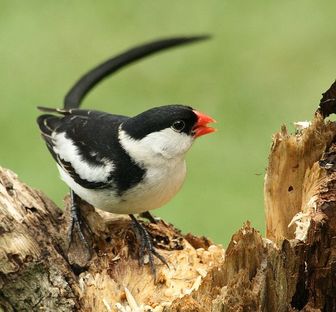Pin-tailed whydah
This whydah is found in many open habitats including open woodland, scrub and cultivation.

Original source: Alan MansonCamera location
Author: Alan MansonCamera location
The Pin-tailed whydah is classified as Least Concern. Does not qualify for a more at risk category. Widespread and abundant taxa are included in this category.
to breed pin-tailed whydahs, one must have at least one mated pair of host birds, synchronized to lay eggs at a time favorable to a mated pair of whydahs. As successful and aspiring breeders can imagine, this can be very tricky, and will likely consume no small amount of time, space and money. However, upon first viewing a male whydah in courtship flight, I immediately understood why many people happily put in the effort. More
The Pin-tailed Whydah, Vidua macroura, is a small songbird. It is a resident breeding bird in most of Africa south of the Sahara Desert. This whydah is found in many open habitats including open woodland, scrub and cultivation. It is a brood parasite which lays its eggs in the nests of estrildid finches, especially waxbills. Unlike the Common Cuckoo, it does not destroy the host's eggs. Typically, 2-4 eggs are added to those already present. More
The Pin-tailed Whydah is 12-13 cm in length, although the breeding male's tail adds another 20cm to this. The adult male has a black back and crown, and a very long black tail. The wings are dark brown with white patches, and the underparts and the head, apart from the crown, are white. The bill is bright red. The female and non-breeding male have streaked brown upperparts, whitish underparts with buff flanks, and a buff and black face pattern. More
Pin-tailed whydah male, in non-breeding plumage, Ntsikeni Nature Reserve, South Africa. Top right: Pin-tailed whydah female, Nylsvlei, South Africa. Bottom right: Pin-tailed whydah male in non-breeding plumage, Milnerton Sewage Works, South Africa. Distribution and habitat Occurs across sub-Saharan Africa, from Senegal to Ethiopia south to southern Africa, where it is common across Zimbabwe, South Africa, patches of Mozambique and northern and eastern Botswana, while more scarce in Namibia. More
The Pin-tailed Whydah is a parasitic species, most often laying it's eggs in the nests of the Common Waxbill, but also Bronze Mannikin, Orange-breasted Waxbill and others. It breeds in the summer months, when the host species are breeding. More
The Pin-tailed Whydah is a Southern African bird that belongs to the Viduidae bird family group which includes birds such as Whydahs, Indigobirds, Cuckoo Finch. The description for the Pin-tailed Whydah (Latin name Vidua macroura) can be found in the 7th Edition of the Roberts Birds of Southern Africa. The Vidua macroura can be quickly identified by its unique Roberts identification number of 860 and the detailed description of this bird is on page 1070. More
The Pin-tailed Whydah is an extremely beautiful bird, especially the male when it's full tail plumage is present. However, for those considering the acquisition of the pin-tailed whydah as a pet, be aware of two important points that I learned the hard way. One, pin-tailed whydah males are, in my experience, extremely aggressive; not only with the other birds, but also with other male whydahs. Aggressive, even in the absence of a female to provoke their rivalry. More
The Pin-tailed Whydah most frequently lays her eggs in the nest of the St Helena Waxbill, Estrildaastrildor the Red-eared Waxbill, Estrildatroglodytes; both make excellent hostsfor Pin-tailed Whydah young. As long asjust one cock and, say, four or five hens are kept, it is well worth experimenting by keeping this species with suitable waxbills since this type of breeding is most interesting to observe. More
The male Pin-tailed Whydah is territorial, and one male often has several females in his small group. He has an elaborate courtship flight display, which includes hovering over the female to display his tail. The song is given from a high perch, and consists of rapid squeaking and churring. The diet of this species consists of seeds and grain. More
